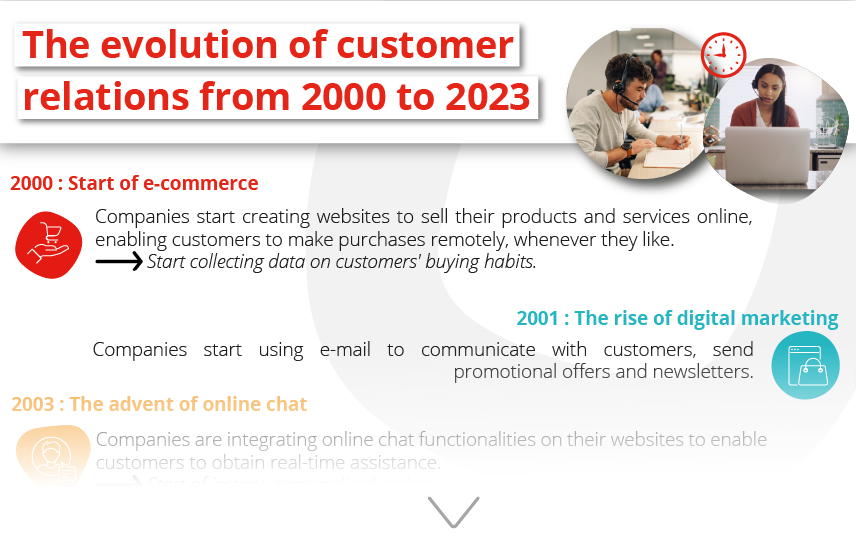The customer relationship is a never-ending loop. A never-ending loop, with customer satisfaction as its goal. The objective remains the same over time, but the challenges are different, as each era brings its own technological advances and social evolutions. Today, the tools available to brands and customers are constantly evolving, reshuffling the deck with each new advance.
Meeting customer service profitability targets, while maintaining a high quality of experience, are the 2 main challenges facing contact centers!
Challenges that digitalization has yet to meet. Indeed, brands have not lowered their costs as much as they would have liked; and the use of new technologies such as Artificial Intelligence and chatbots still has some way to go, before achieving the expected quality.
That’s why, at Vocalcom, we’re convinced that one of the ways to increase customer service quality, while lowering contact center costs, is to be proactive.
Let’s take a look back at the evolution of the customer relations sector over the last 20 years. How has digitalization impacted customer service ? What solutions can be put in place to achieve the objectives set at the beginning of the millennium?
Over the past two decades, customer relations have undergone a metamorphosis, moving from a traditional model centered on face-to-face interactions and phone calls to a multi, then omnichannel digital environment. The rise of social media, smartphones and other connected technologies has created new opportunities and challenges for companies in the way they manage their customer relationships.

The digitalization of customer relations has brought many benefits. Customers now have instant access to information, can interact with brands at any time and expect greater personalization and responsiveness. Companies, for their part, have access to a wealth of data on customer behavior, preferences and needs, enabling them to better understand them and propose more targeted offers.
The evolution of customer relations has also been driven by the integration of emerging technologies such as artificial intelligence, process automation and data analysis. These innovations enable companies to offer more personalized customer experiences, improve operational efficiency and deliver faster, more effective services.
However, this digital transformation also raises challenges. Companies must adapt to an ever-changing landscape, be present on a multitude of communication channels and manage ever-greater volumes of data. They must also maintain a balance between technology and the human aspect of customer relations, offering personalized, empathetic interactions.
Demand delta is the difference between customer requests and the company’s ability to meet them. In other words, demand delta represents the difference between the amount of work customer service needs to do to respond to customer requests and the amount of work customer service is able to do within a certain timeframe. If demand exceeds the company’s ability to respond, this can lead to problems such as extended waiting times, inferior service quality and customer dissatisfaction. It can also have a negative impact on the company’s reputation and ability to build loyalty.
That’s why it’s important for companies to monitor their delta demand and regularly measure their response capacity and customer satisfaction levels, in order to take steps to reduce delta demand if necessary. This may include hiring additional staff, improving processes and technologies, or setting up mechanisms to prioritize customer requests according to their level of importance.
Companies can also use data analysis tools to forecast future demand and plan their response capacity accordingly.
Demand delta is a key issue, as it can have a significant impact on customer satisfaction, customer retention and company profitability. By monitoring and managing it effectively, companies can improve their performance, strengthen their reputation and increase their competitive edge.
Referring to a significant increase in customer interactions, delta demand has an impact on :
At Vocalcom, we believe that the best way to reduce delta demand and thus satisfy customers is to offer proactive engagement strategies. Be where the customer doesn’t expect you to be: responding to their needs, before they know they have them.
Today’s consumers are no longer satisfied with attractive prices, even when these prices reflect quality service. They are looking for a truly omnichannel customer experience, with personalized offers, innovative products and, above all, proactive customer service. 67% say they are willing to pay more for a better customer experience.
Beyond reducing delta demand, proposing proactive engagement strategies responds to consumer demand and enables brands to stand out from the crowd. In an increasingly saturated market, the only way for brands to differentiate themselves is to address the right customers, at the right time, and respond to their expectations with relevance.
Developing proactive engagement strategies therefore helps you reduce delta demand in several ways:
We’ve written an article detailing how to offer proactive customer service . We invite you to read it, if you’d like to explore the subject further.
To create more proactive campaigns, certain essential steps must be followed:
To deliver a proactive customer experience, investing in the right technologies is essential. In particular, it enables companies to optimize their response capacity, and thus better meet customer demands.
By taking a proactive approach to customer relations, you show your customers that you care about them and are ready to anticipate and respond to their needs. This can boost customer loyalty and satisfaction, leading to better retention and growth for your business.